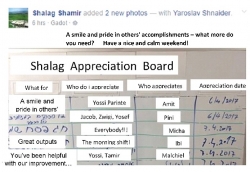This is the first chapter from my new book: Manage! Best Value Practices for Effective Management. the full book is can be purchesed on Amazon - click here to see more details.
The purpose of this book is to provide a fresh look on how you can improve business results by making your company matter to your employees.
The first part, which is presented here, presents the author's choice of 12 leadership principles. The second part discusses the relationship between the CEO and the management team as well as the relationship between the CEO and the board of directors. The third part describes with many examples how to lead the organization by engaging the employees. In the last part you will find a selection of vital tools for performance measurement, root cause analysis and problem solving.
The book's cover:
https://business-excellence.co.il/en/my-blog/534-twelve-principles-of-effective-management#sigProIda626c940f0
Twelve principles of effective management
Looking back on my twenty years as chief executive officer (CEO) and consolidating the wisdom and experience of dozens of CEOs and executives with whom I have worked as a business consultant, here are my 12 "golden" rules for effective management. For simplicity, I refer here to the CEO-Level. However, the same principles apply to any management level.
Note: Any reference to gender in this book is incidental; the statements apply to male and female managers interchangeably unless specifically mentioned otherwise.
1. Leadership
The CEO is accountable for the business results of the company. In order to achieve the best results, the CEO must lead and manage the company according to an explicit roadmap, while responding decisively to threats and opportunities in the business environment. A CEO should be open-minded and attentive to subordinates, but should never hesitate to confront senior managers and
other internal power holders, who might challenge and/or resist her intentions .
I have met quite a few managers who avoid managing their subordinates. In one extreme case, the CEO (who was also the owner) of a company struggling for survival preferred to hide in his office and anxiously watch the deterioration of his firm into insolvency. Even though the reasons for the downhill slide were clear, he was afraid to confront his subordinate managers, mainly because they were members of his family. Extreme as it may sound, cases of CEOs who are afraid to confront the centers of power under them are quite prevalent.
Leadership is by far the most important trait of successful management and is relevant for all organizations. The importance of the following principles may change from one organization to another. But all of them are indispensable for sustainable profitability and growth.
2. Vision
The vision statement of an organization defines the direction and the values that are its reasons for existence. The omission of a vision statement often stems from a lack of definite direction. In the absence of a clear vision
the growth of a company will be coincidental and short-lived. The vision statement must be revisited every few years in order to deal with changes in the business environment. Involving relevant thinkers from all parts of the organization (and sometimes even from outside) in such vision reviews is recommended.
3. Strategy, Business Policies and Plans
These are derivatives of the vision statement. Without them the evolution of the company will be somewhat unpredictable. Here too, responsiveness to the market dynamics is crucial, and teamwork is most advisable.
4. Honesty
When the CEO does not behave truthfully and sincerely, this attitude is internalized; sooner or later the employees will respond with diminished integrity. In several companies in which employees were guided to submit false reports to the authorities, I found that the employees used to steal
from the company. These are harsh words, but reflect reality.
5. Fairness
When the CEO behaves unfairly and uses double standards toward employees, disloyalty and embitterment ensue at all levels of the organization. Incidents of unfairness travel fast by word of mouth. The CEO should make every effort to convince his employees that his actions are motivated by reason; that he cares for the well-being of the company; and that he is free from personal bias.
6. Personal Example
All managers and employees, down to the last one, watch what the CEO does and not merely what he says. A manager whose actions contradict his words will not be able to establish the organizational culture based on his stated principles and values. For example, if a CEO never shows up at work before 10:00 am and is usually late for meetings, his demands for efficient meetings which always start on time will not be taken seriously. The same goes for values such as honesty, truthfulness and loyalty.
7. Transparency
The more employees and managers are exposed to information about company goals and its performance, the more possible it is to harness their sense of partnership for the company's success.
Transparency adds power to an organization. Hiding information creates a break between the employees and the company; it diminishes their identification with the company, its goals and its pursuit of profit.
Transparency does not mean that everyone knows everything. However, I strongly believe that all sales people should be exposed to the sales targets and the sales results on a regular basis. Similarly, it is appropriate to reveal production targets and results to all production employees. By sharing information with employees, we signal our trust in them and invite them to feel part of the effort.
Information hiding occurs primarily in small, family-owned firms. Larger companies, especially public ones, are not only required by law to report
business results, but also understand its importance as a motivator for employees to identify with the organization and contribute to its success.
8. Attentiveness
Employees and their managers are a valuable source of information about weaknesses and process improvement. A manager who listens to employees carefully, with personal attention, encourages innovation and boosts employee motivation at all levels.
9. Discipline
Attentiveness, fairness and sense of comradery should not relax the demand for discipline. All of us have been testing boundaries since we were children and we will continue to do so for the rest of our lives. The key to repetitive success is disciplined implementation of effective business processes.
Consider the following: An employee smokes a cigarette at his workstation while operating a lathe. His manager asks him to put out the cigarette and reminds him that smoking is allowed only in designated areas. The following day, at the end of the work shift, after changing out of his work uniform, the same employee lights a cigarette outdoors and walks into the workshop smoking near the manager.
How should the manager respond?
If this manager or the CEO does not define clear cut boundaries and enforces discipline, he will not be able to lead the company to its goals.
10. Planning
In order to realize company strategy and achieve company goals, it is necessary to outline a multi-annual work plan and set quantitative
objectives accordingly. The annual objectives of the current year should be monitored on a monthly basis.
See more in Improving company performance and endurance using monthly targets.
11. Delegation of responsibility
The CEO is accountable for the business results. However, the CEO cannot and should not do everything by herself. In order to harness the senior managers to the success of the company she must delegate clear
responsibility with adequate authority to each of them. Her task is then to monitor the senior managers' progress according to their respective work plan and help them resolve conflicts and contingencies as they arise.
See more in The CEO and the management– delegating responsibility.
12. Monitoring
Finally, after the work plan has been defined, objectives set and responsibilities delegated, the CEO must implement a persistent monitoring routine with quantitative measurements. Resisting the temptation to intervene with the work of his subordinate managers, the CEO should examine their results in light of their targets at least once a month. Whenever a delay or a deviation from the work plan is identified, the relevant manager should submit a corrective action plan for review by the CEO and the other managers at a management meeting.
You can purchase the full book on Amazon, or directly through me. If you prefer to obtain it directly just send me a message.













 My First Book: Manage! Best Value Practices for Effective Management
My First Book: Manage! Best Value Practices for Effective Management